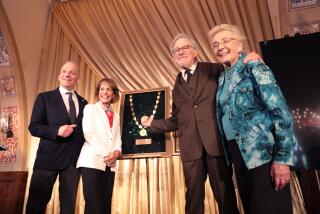A dream that came out of a nightmare
- Share via
Last August, Universal Studios released the 25th anniversary “Double Secret Probation” disc of “Animal House” with a parade and mock food fight on Hollywood Boulevard. In September, Jay-Z hosted a hip-hop party in Puerto Rico to promote Universal’s re-release of Brian De Palma’s “Scarface.”
But the event last week marking today’s DVD release of “Schindler’s List,” a film chronicling one man’s efforts to save Jews from the Holocaust, was a low-key affair held in a tented parking area on the Universal Studios lot. It included a press question-and-answer session, a video tour of the Survivors of the Shoah Visual History Foundation (housed in a series of trailers there) and a plea for tolerance by filmmaker Steven Spielberg, who spoke flanked by the cast members, Holocaust survivors and teenagers featured with them in a new video about bias and bigotry. “Making the film had been a nightmare of living those horrific memories,” Spielberg said before embarking on a tour of the foundation’s quarters. “But the accomplishments of this foundation have become a dream.”
With his celebrity cachet and the current socio-religious climate, Spielberg could have easily generated substantial buzz -- and sold a fair number of discs -- by simply answering reporters’ persistent questions about Mel Gibson’s recently released “The Passion of the Christ.” But he declined to take the bait, stating that once he sees the movie (he hadn’t as of the middle of last week), the first person to hear his comments will be Gibson himself.
Instead he focused on the Visual History Foundation, an organization that he established in 1994 after meeting with Holocaust survivors on the set of “Schindler’s List,” and that he called “the most important work of my life aside from my family.” The foundation’s original goal, met within five years, was to collect the visual history testimonies of 50,000 Holocaust survivors.
Douglas Greenberg, the foundation’s president and chief executive, who led Spielberg, the survivors and cast members Ralph Fiennes, Ben Kingsley, Embeth Davidtz and Caroline Goodall on a tour of the group’s offices, later acknowledged the challenges of marketing such a film. “Universal felt -- and Steven especially felt -- that this had to be done in a very sensitive way,” he said. “We’re not selling candy bars here. We’re selling a movie of very unusual character and the idea of being salespeople for such a thing is something I don’t feel comfortable about, that I don’t think Steven feels very comfortable about. That’s what having this event was all about.”
“We had been talking about ‘Schindler’s List’ on DVD for years,” noted the president of Universal Studios Home Video, Craig Kornblau (whose own father-in-law is one of the 52,000 survivors profiled in the archive). “And we felt we had to pick a respectful and appropriate time.” He said the release date, chosen more than a year ago, was timed to coincide with the 10-year anniversary of the film’s seven Academy Awards (including best picture and best director) and the foundation’s 10th anniversary.
While a DVD release is often an opportunity for filmmakers to include outtakes, deleted scenes, comical bloopers or hidden bonus features (known as “Easter eggs” to DVD enthusiasts), the “Schindler’s” DVD strikes a tone in keeping with its subject matter. A single, unmarked disc (playable on both sides) contains the movie, cast biographies, information about Oskar Schindler and a 77-minute documentary called “Voices From the List” that features the testimonies of Schindler survivors culled from the foundation collection. It also includes “The Shoah Foundation Story,” a 12-minute video narrated by Morgan Freeman that details continuing efforts to catalog, index and disseminate the archived material.
That video, screened at the event, ends in a plea to support the foundation’s work by contributing. It seemed a bit incongruous, and made the “Schindler’s List” DVD release seem, at least for a fleeting moment, like some sort of high-production-value fundraising video.
But Holocaust survivor Celina Biniaz put the film in proper perspective when she took the microphone and, in a voice cracking with emotion, summed up what may prove to be the lasting legacy of Spielberg’s 1993 movie. “I was 13 years old when I was liberated from Schindler’s camp,” she said. “And I told Mr. Spielberg that Schindler saved my life. But this picture, ‘Schindler’s List,’ gave me a second life.”
More to Read
The biggest entertainment stories
Get our big stories about Hollywood, film, television, music, arts, culture and more right in your inbox as soon as they publish.
You may occasionally receive promotional content from the Los Angeles Times.











